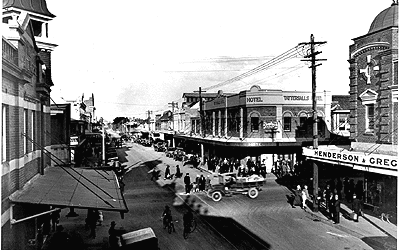Commercial Ventures - Overview
As the colony was settled and towns evolved, small businesses established in these centres to serve the growing needs and demands of the settlers. Initially these were general stores selling a wide range of products, plus bakeries, butchers and blacksmiths shops and eventually developing into commercial centres with banks, hotels and speciality stores.
Parramatta was recognised early as a major centre and by 1792 markets were established to sell produce. Although Sydney and Parramatta were recognised as the main centres towns such as Windsor, Liverpool and Campbelltown also flourished during the early nineteenth century with a large number of stores and businesses.
With the opening up of land in New South Wales, many more towns developed along the routes with a particular growth noted during the rush for land out west and the Gold rush period of the 1850s. Along these roads in Western & South Western Sydney, small centres were established often with a general store plus a hotel acting as the coaching depot and offering accommodation and food.
From the 1860s the railway extended west and this frequently increased the local population and the economy. Small townships also sprouted up along the route at the location of the new platforms. As well as schools and churches a selection of shops and businesses became established, including butchers, bakers, banks, blacksmiths, grocery stores and chemists etc. Subsequently tailors, clothing apparel, jewellery and speciality stores appeared.
As the population steadily increased and urbanisation began to creep west, some areas noted big developments. Other places such as Windsor, Camden and Campbelltown although significant rural towns, did not seize the opportunities of growth.
The first liquor licenses were distributed in the colony shortly after settlement and hotels were usually one of the first buildings established in a centre. As well as supplying alcohol and food, administering to the comforts of travellers, hotels were also social meeting places. During the nineteenth century in Western and South Western Sydney, most towns recorded an abundance of hotels and inns. Hotels provided the bulk of entertainment and were used as venues for various public activities if no hall was available.
By the twentieth century most shops were situated close to the Railway Stations and large department stores were appearing in centres other than in Sydney and Parramatta. The shift from small speciality stores to large supermarkets began to appear in the 1970s and the establishment of large specially designed shopping centres commenced. The growth of the shopping centres resulted with a range of stores and supermarkets under the one roof but also meant financial ruin for many small retail stores located in the traditional main street.
A distinctive aspect of the 1980-90s is bulk retailing. Parramatta Road in Auburn, Liverpool Road and Church street are home to large warehouse and retails centres that also sell cheaply to the public. Another unique characteristic of the 1980s was the closure of the main street to vehicular traffic in some centres to form a pedestrian mall. Blacktown and Penrith are two centres that found these malls restricted retail growth and have recently resurrected their main streets.
Tourism
Tourism has played an important role
in the economy in a number of areas in Western & South Western Sydney
during the late nineteenth century, particularly in the Blue Mountains and
to a lesser extent in the Hawkesbury and Nepean districts. As we head into
the 21st century people have increased leisure time, improved transport and
money resulting with tourism playing a vital role in a number of Western & South
Western Sydney communities, generating employment and assisting with the
economy.
 Typical style of shopping centres built
in the 1960s. Wentworthville Shopping Mall, 1962. Photo Acknowledgement : Holroyd
City Council Library.
Typical style of shopping centres built
in the 1960s. Wentworthville Shopping Mall, 1962. Photo Acknowledgement : Holroyd
City Council Library.
 Parramatta the main central business
area outside Sydney in the 1930s. Photo Acknowledgement : Parramatta City
Council Library.
Parramatta the main central business
area outside Sydney in the 1930s. Photo Acknowledgement : Parramatta City
Council Library.